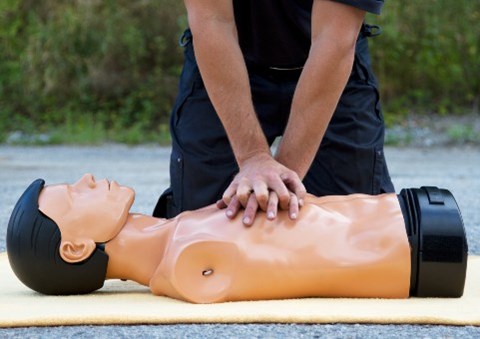Exploring the role of drone-delivered defibrillators in cardiac arrest emergencies


Can drone delivered defibrillators improve outcomes in cardiac arrest? What we learned from simulations and interviews with the public
Background to the work
Out-of-hospital cardiac arrest is when a patient’s heart stops suddenly in the community. It is a leading cause of death in the UK as without rapid treatment, it can lead to death within minutes.
We know that early CPR (chest compressions) and fast access to a defibrillator can significantly increase the chances of survival.
Defibrillators are often placed in public places like village halls or shops, but in an emergency, it can be difficult to leave someone to go and fetch one. One approach being tested around the world is using drones to deliver a defibrillator directly to the emergency.
This removes the need to go searching – as it comes to you. But while several countries are testing this technology, there is limited research about how the public would actually respond to using it in a real situation.
The research
Researchers performed two linked studies that explored the human interaction with drone-delivered defibrillators. They looked at how members of the public interact with this technology, especially under stress, and what they think about its use in real emergencies.
In the first study, members of the public took part in a simulated cardiac arrest scenario, with a defibrillator ‘delivered by drone’ arriving during the situation. The team looked at how long CPR was paused for and collected feedback on the experience.
In the second study, researchers interviewed a separate group, who were all older adults (aged 65+) to understand their thoughts and feelings about drones delivering defibrillators in real-life situations.
Together, these studies found that people generally support the idea of drones helping in emergencies. But many still feel unsure about how to use the defibrillator or what to do if they’re alone. The research highlights the importance of further research to improve how we implement this technology in the future.
Who is this evidence useful for?
Emergency service planners, NHS ambulance services, pre-hospital clinicians, public health decision-makers, drone technology developers, local authorities, and community first-aid training organisations.
More detailed summaries of the two separate research studies are given below
Simulation study:
Interview study with older adults:
What did the research find?
In the simulation study:
In the interview study:
Why is this important?
These findings suggest that drone-delivered defibrillators could improve access to life-saving treatment, but only if the public feels confident and supported.
Pausing CPR for too long, confusion about how to use the equipment, or fear of doing the wrong thing could all reduce the potential benefit.
Support from emergency call handlers was particularly important and must be carefully integrated into future systems.
Key recommendations for policy and practice
What happens next?
Further research is needed to test these systems in real emergencies and with more people. The research team also want to explore how to reduce pauses in CPR and build the public’s confidence when using a drone-delivered defibrillator.
Public and patient involvement
Members of the Patient, Carer and Public Involvement (PCPI) group at the University of Sunderland helped shape the study design at early meetings. We also invited participants to take part through the same group.
Acknowledgements
This work was led by Owen Finney as part of a Masters Degree funded by the NIHR Applied Research Collaboration (ARC) North East and North Cumbria (NENC).
It received in-kind support from the University of Sunderland and NEAS. The project exemplifies collaborative, low-cost applied research with meaningful public involvement.
Researchers from several other institutions were also involved, helping strengthen the breadth and quality of the work.
These include:
Northumbria University
University of York
University of Leeds
Leeds Teaching Hospitals NHS Trust
Newcastle University
South Tees NHS Foundation Trust
University of Hertfordshire
Warwick University
Get in touch to find out more
Lead Researcher: Owen Finney
[email protected]
🔗 ORCID Profile
Read the full research papers
Contributors